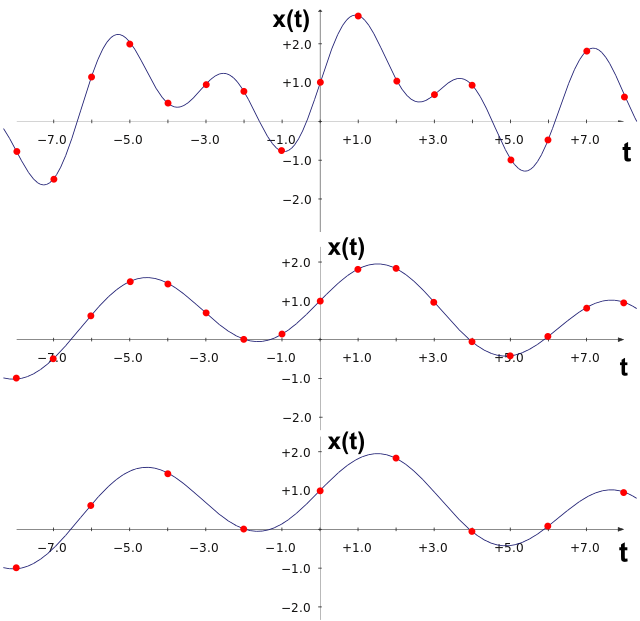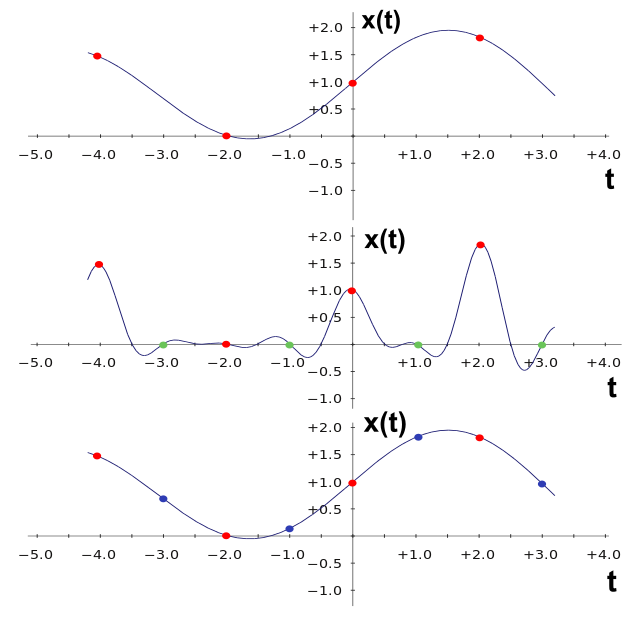Abstract
Content
- Introduction
- 1. Theme urgency
- 2. What is sound effects?
- 3. Transformation methods of sound
- 3.1 Resampling
- 3.2 Decimation
- 3.3 Interpolation with a coefficient
- 3.4 Resampling using polyphase filters
- Conclusiont
- References
Introduction
Technical progress of computers brought a digital processing technology and sound synthesis. Thus the old methods have been improved sound synthesis and processing principles, and was invented many new ones.
The purpose of this paper is to find a computer algorithm analysis and transformation of one-dimensional signal (sound), which would be different from previous studies.
1.Theme urgency
Technology parameter control computer sound transformation can be used not only in the processing of audio or music recordings, but when playing back speech material, for example, to reduce the monotony of listening long fragments.
2. What is sound effects?
Sound effect – artificially created or enhanced sounds, or sound processing used to emphasize artistic or other content of movies, video games, music or other media.
Technical sound effects
Typical sound effects that are used in the preparation of audio content are:
- echo – one or several delayed signals that are added to the original. To effect perceived as echo, the delay should be of the order of 50 milliseconds or more. This effect can be achieved with both analogue and digital processing. If a significant number of delayed signals played for a few seconds, the resulting signal has the effect of being in a large room and is perceived as a reverb effect.
- flanger – the delayed signal is added to the original variable delay of up to 10 milliseconds. This effect is achieved by the digital processing, playback is achieved while the same recording synchronized recording of two players and the subsequent mixing.
- phaser – splits the signal, part of it is filtered by phase filter to generate phase shift and then filtered and unfiltered signals are mixed. Phaser effect similar to the effect flanzheru, but it is difficult to reproduce the analog equipment. Phaser is used to achieve the "synthesizing" or "electronization" natural sounds such as human speech.
- chorus – the delayed signal is added to the original constant delay. The delay should be small to minimize the effect of the echo, but more than 5 ms, otherwise lead to interference wave flanging effect. Often delayed signals are shifted slightly in height to achieve a more realistic effect, ensemble sound.
- equalization – different frequency bands are strengthened or weakened to adjust timbral characteristics. Is a kind of sound filtering. Shorten – EQ.
- filtering sound – a process using various types of audio filters. Bandpass filtering of voice can simulate the effect of conversation.
- overdrive – effect produces distorted sounds can mimic the voice of a robot or radiotelephone signals. Classic overdrive leads to pruning (clipping) signal when its absolute value exceeds a certain threshold.
- pitch shift raises or lowers the pitch of audio signals. This effect is often used to correct singing pop singers singing out of tune. Playback speed (tempo), however, remains constant.
- time stretching – unlike of pitch shift, this effect audio playback speed (tempo) without changing its height.
Synthesizer - artificially creates practically all sounds, imitating natural or creating an entirely new.
Modulation - to change the carrier signal parameters (frequency, amplitude, etc.) with a control (modulating) signal, which contains information about the change [3].
Compression – decrease in the amplitude range of sound in order to prevent spontaneous oscillation dynamics.
3. Transformation methods of sound
Digital signal is obtained from the analog sampling operation - taking samples (measurement) at a time interval T. In principle, possible and digital processing with nonuniform sampling time, but this topic is far less developed mathematically and, apparently, is not so great practical interest. In this operation seems possible loss of information contained in the signal values ??in the intervals between samples. Conditions under which recovery is feasible by the analog signal obtained from it digital, ie initially retain all information contained in the signal, expressed Nyquist theorem-Whittaker-Kotelnikov-Shannon. This requires that the bandwidth of the input signal would not be less than twice the narrower than the sampling frequency, i.e. fc = 1/2fd. (Often lead her private formulation is valid for signals whose frequency band starts from zero frequency - not to present frequency greater than half of the "sampling rate") [6].
3.1 Resampling
Resampling - resample discrete (mostly digital) signal. Resampling algorithms are widely used in the processing of audio signals, radio signals and images.
The signal samples corresponding to the new sampling frequency, calculated by existing counts and contain no new information [4].
Increasing the frequency of sampling is called interpolation, lowering – decimation.
When sampling the signal samples corresponding to the same sampling rate, calculated from the available readings of the same signal corresponding to another sampling rate (assuming that both the sampling frequency correspond to the conditions Kotelnikov theorem). Ideal recovery oversampling equivalent continuous signal sampled at a subsequent discretization it on the new frequency.
The exact calculation of the value of the original continuous signal at a certain point as follows:
 ,
,
where x (ti) – i-th signal sample, ti – a time corresponding to this countdown, d = 2*fd – cyclic sampling, x (t) – interpolated signal value at time t.
In real life, interpolation is performed using other filters, with an expression for it takes the following form:
where h (t) - impulse response corresponding reconstruction filter. View this filter is selected depending on the task.
Direct calculation of the new signal samples by the above formulas requires significant computing resources and undesirable for real-time applications. There are important special cases of sampling for which the calculation is made simpler new readings:
- with a decimation factor (reducing the sampling rate by an integer);
- an interpolation coefficient (increasing the sampling rate by an integer);
- resample in rational (M/N) number of times (this case may be regarded as a combination of the previous two.)
When such restrictions becomes convenient use of standard implementations of digital filters for oversampling.
3.2 Decimation
Process of reducing the sampling frequency is called decimation. Sometimes this term is used only to reduce the sampling rate by an integer (the N). Decimation of a digital signal with a ratio in two stages:
1. Digital signal filtering to remove high-frequency components that do not satisfy the conditions of Theorem Kotelnikov for new sampling frequency;
2. Deleting (dropping) extra samples (saved each N – report).

Figure 1 - Illustration of a discrete signal decimation algorithm
3.3 Interpolation with a coefficient
Called interpolation increased frequency in whole or fractional numbers [2] by calculating intermediate times on existing. Ideal interpolation accurately restore the signal to intermediate times.
Standard signal interpolation algorithm with a factor is as follows [5]:
1. Insert zero samples in place of samples that need to be calculated;
2. Signal filtering a digital lowpass filter to remove spectral components of the signal, which obviously could not be in the original signal by Theorem Kotel'nikova; filter output is multiplied by the interpolation factor for valuation.
In English literature the first of these stages is sometimes termed upsampling. In the common parlance, the term can be used as a synonym for "interpolation".
If implemented in software interpolation zero samples are not involved in the computation of the filter output signal, which optimizes the process of computing. For a hardware implementation to conserve resources may use polyphase filters.

Figure 2 - Illustration of the interpolation algorithm of discrete signal
3.4 Resampling using polyphase filters
Resampling method using polyphase filters similar to the preceding one, with the difference that instead of one there filter operating at a high sampling rate is used a number of filters operating at a low frequency. Thus it is possible to achieve reduction in the number of calculations required, as each frame is necessary to calculate the output of only one of these filters [1].
Polyphase filter is a set of small filters operating in parallel, each of which handles only a subset of signal samples (if available all N filters, each filter will process only every N-th count).
Polyphase filters used for sampling as a whole and fractional–N [1].
Conclusion
On the basis of theoretical knowledge will be created for audio conversion algorithm VST-plugin [7], which can be connected to any host audio editor program.
In writing this essay master's work is not yet complete. Final completion: December 2014. Full text of the work and materials on the topic can be obtained from the author or his manager after that date.
References
Wikipedia [electronic resource]. – Режим доступа: http://ru.wikipedia.org
-
Sekunov Audio processing on the PC/ Sekunov. – Saint–Petersburg, 2001. – 1248 p.
-
Handout subject "Digital Signal Processing" / Сост. А.В. Самощенко.– Донецк: ДонНТУ
-
Цифровая обработка сигналов. А. Б. Сергиенко. СПб, Питер, 2011. —758 с.: ил.
-
Цифровая обработка сигналов. Рабинер Л., Гоулд Б. 1978. —847 с.: ил.
The literature on digital signal processing [electronic resource]. – Режим доступа: http://dsp-book.narod.ru/
-
Portal for advice in creating vst–plugins [electronic resource]. – Режим доступа: corpuscul.net
